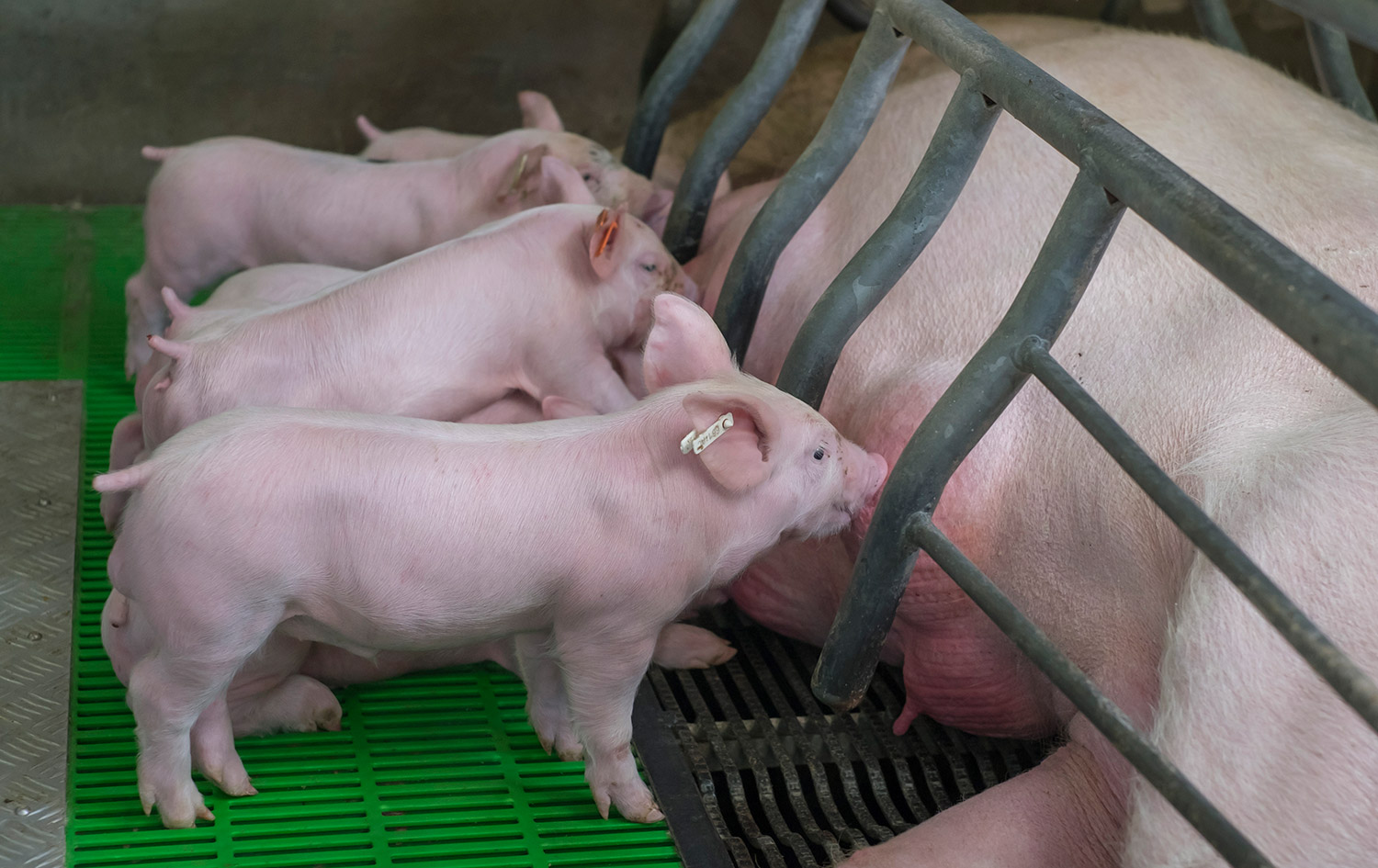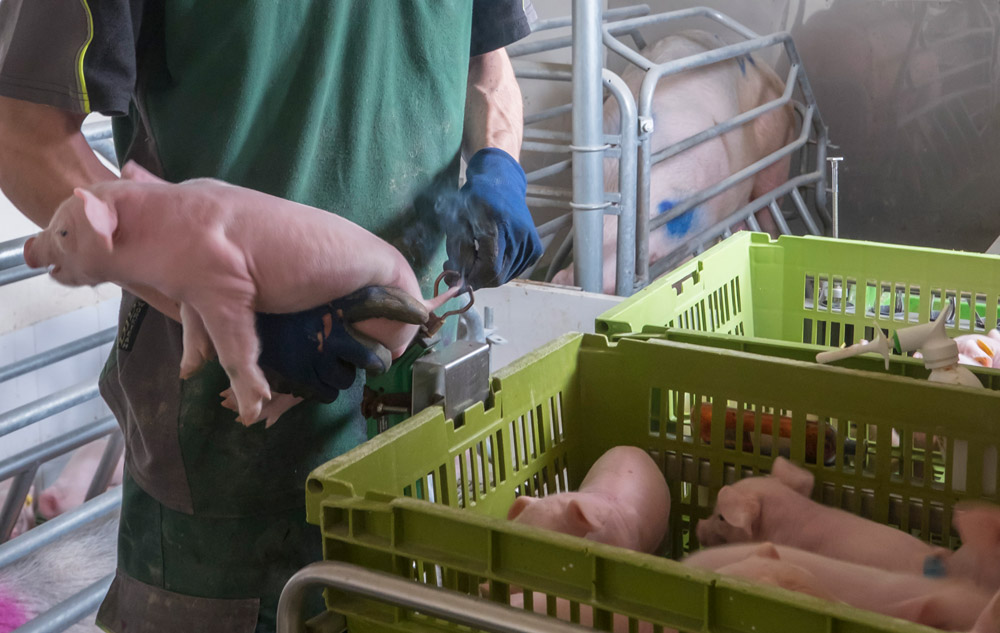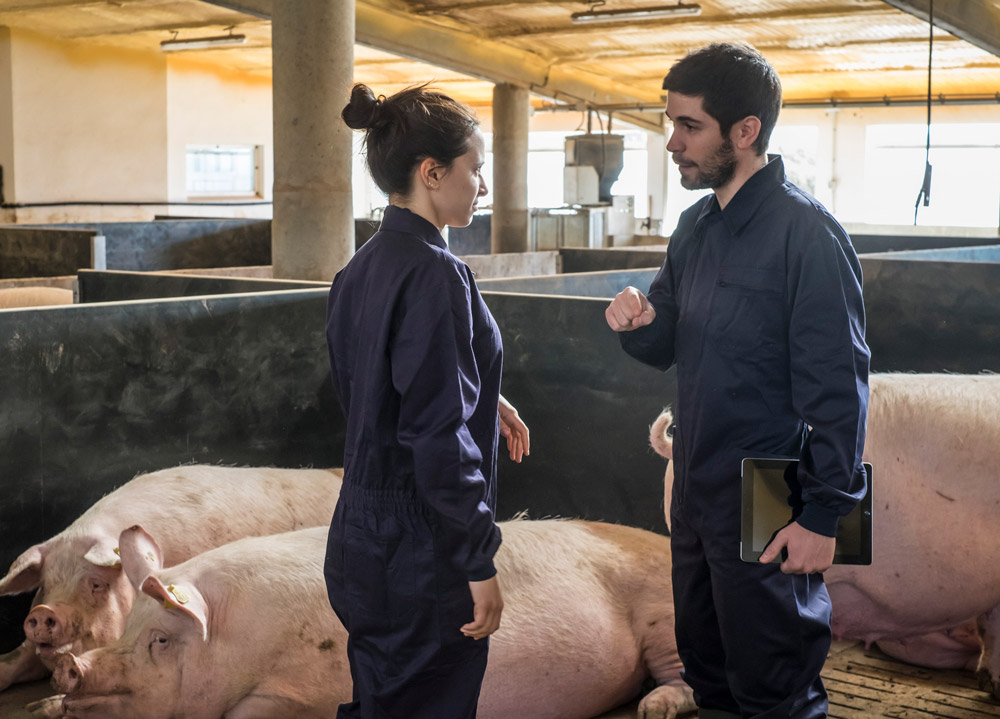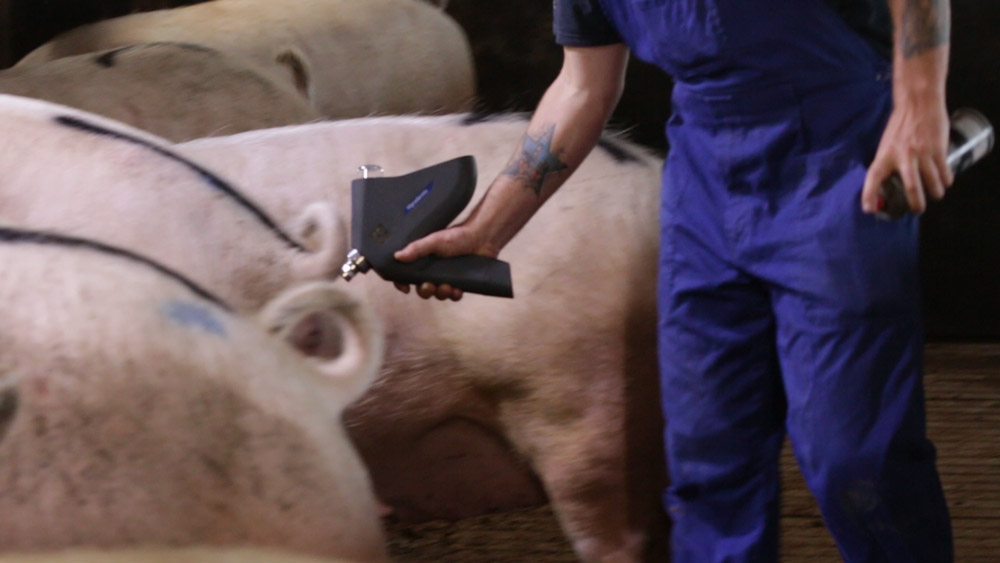
Mycoplasma hyopneumoniae control: 4 factors that could affect the enzootic pneumonia in your farm
Control of Mycoplasma hyopneumoniae (M. hyopneumoniae) infections in pig herds can be accomplished by optimizing management and biosecurity practices and housing conditions (Maes et al., 2008). However, these measures might not always provide the desired improvements and/or it might be difficult to implement changes because of financial, logistic and practical constraints. In that case, vaccination against M. hyopneumoniae is a very useful tool to control M. hyopneumoniae infections. In infected herds, vaccination improves the health and performance of the animals and reduces the use of antimicrobials. Vaccination is frequently practiced worldwide, and different M. hyopneumoniae vaccines are available. Commercial vaccines are mostly bacterins that are licensed either for single or double vaccination in piglets. Some vaccines are also licensed for use in breeding animals. Most bacterin vaccines should be administered intramuscularly, but some of them are licensed for intradermal administration (Maes et al., 2020). In this article we would like to highlight 4 factors that could affect the enzootic pneumonia in your farm.
1-Piglet vaccination against Mycoplasma hyopneumoniae
The advantages of piglet vaccination are a decrease of the performance losses due to M. hyopneumoniae infections: improvement of average daily gain (ADG) (2-8%), feed conversion ratio (2-5%) and sometimes mortality rate (Del Pozo Sacristan, 2014). Additionally, shorter time to reach slaughter weight, less variation in slaughter weight (more homogeneous carcasses), reduced clinical signs (coughing), lower prevalence and severity of Mycoplasma-like lung lesions and lower treatment costs are observed (Maes et al., 1998, 1999; Jensen et al., 2002). Although M. hyopneumoniae infections do not cause pleurisy lesions, infections gained early during the rearing of fatteners have been shown to predispose for pleurisy recorded at slaughter (Holmgren et al., 1999). Correspondingly, studies showed that Mycoplasma hyopneumoniae vaccination may lead to a decrease in pleurisy in slaughter pigs (Maes et al., 1999; del Pozo et al., 2014), probably due to a lower number of secondary bacterial infections such as those with Pasteurella multocida and/or Actinobacillus pleuropneumoniae (Marois et al., 2009). The currently used vaccines also reduce the number of M. hyopneumoniae organisms in the respiratory tract (Meyns et al., 2006; Vranckx et al., 2012) and decrease the infection level in a herd (Sibila et al., 2007).
However, the protection against clinical signs and Mycoplasma-like lung lesions is often incomplete and vaccination does not prevent colonization. Transmission models under experimental (Meyns et al., 2006) and field conditions (Pieters et al., 2010; Villarreal et al., 2011) showed that vaccination conferred only a limited and non-significant reduction of the transmission ratio of M. hyopneumoniae. Therefore, these authors concluded that vaccination as only control measure will not eliminate Mycoplasma hyopneumoniae from infected pig herds. The effects of vaccination may also be variable between herds. This may be caused by non-compliance with the basic principles of good vaccination practices e.g. improper storage conditions and administration of the vaccine, poor hygiene at vaccination, and not following the guidelines mentioned in the leaflet. However, also other factors such as stress at vaccination, infections with other pathogens at the moment of vaccination, co-infections involved in porcine respiratory disease complex (PRDC), diversity of M. hyopneumoniae strains, and maternal immunity might influence vaccination efficacy (Maes et al., 2020).

2-Mycoplasma hyopneumoniae vaccination moment
In M. hyopneumoniae-free herds or in herds with very low infection levels, vaccination may not be recommended since under these conditions, the benefits of vaccination may not outweigh the costs. In other farms, different vaccination strategies have been adopted, depending on the type of herd, production system and management practices, infection pattern and preferences of the pig producer.
Since infections with M. hyopneumoniae may already occur during the first weeks of life (Villarreal et al., 2010), vaccination of piglets is the most common vaccination strategy. Its efficacy has been demonstrated in numerous experimental and field studies (Jensen et al., 2002). Vaccination of suckling piglets (early vaccination; < 4 weeks of age) is most common, especially in single-site herds, whereas vaccination of nursery/early fattening pigs (late vaccination; between 4 and 10 weeks) is sometimes practiced, especially in three-site systems where late infections are more common. Originally, double vaccination was the most frequent practice. Currently, one-dose vaccination is more frequently used, mainly because it requires less labor and it can be implemented more easily in routine management practices at the farm (Baccaro et al., 2006). With one-dose vaccines, the skill of the pig producer or employee to vaccinate properly might be more critical for vaccine compliance since only one injection is administered. Single vaccination at either 7 or 21 days of age was efficacious (performance, lung lesions) in a pig herd with clinical respiratory disease during the second half of the fattening period (Del Pozo Sacristan et al., 2014). Experimental (Arsenakis et al., 2016) and field studies (Arsenakis et al., 2017) have shown that vaccinating piglets three days prior to weaning conferred slightly better results (performance, lung lesions) than vaccination at weaning. An overview of the effect of piglet vaccination obtained in different studies on lung lesions and other parameters have been published by Del Pozo Sacristan (2014). Reductions of 5% to more than 50% in the prevalence of pneumonia lesions were obtained, along with a significant reduction in the severity of the lesions. A meta-analysis, based on 63 M. hyopneumoniae vaccination studies showed that vaccinated animals on average had 22 gram higher ADG than non-vaccinated animals (Jensen et al., 2002).
As a general rule, vaccination needs to be administered before animals become infected. Vaccination of suckling piglets has the advantage that immunity can be induced before pigs become infected with Mycoplasma hyopneumoniae, and that less infections with other pathogens are present that can interfere with the immune response. Nursery pigs have a lower level of maternal immunity but may already be infected with M. hyopneumoniae (Villarreal et al., 2010). In addition, the age-window in which piglets become infected may vary between successive groups within a herd (Sibila et al., 2004). Vaccination strategies tailored to specific farm infection patterns e.g. vaccination of piglets at least two weeks prior to seroconversion have been successful in decreasing the impact of M. hyopneumoniae infection (Wallgren et al., 2000). Some pathogenic infections e.g. with porcine reproductive and respiratory syndrome virus (PRRSV), porcine circovirus type 2 (PCV-2) or S. suis mainly take place after weaning and may affect the general health status of the pigs, and consequently interfere with proper immune responses after vaccination. Also, in case of intramuscular administration, iatrogenic transmission of these pathogens may take place during vaccination.

3-Aclimatization of breeding gilts and sow vaccination
Vaccination of breeding gilts during gilt acclimation or quarantine unit is commonly practiced (Garza-Moreno et al., 2018). Vaccination is recommended in case negative gilts or gilts with unknown infection status will enter a herd that is infected with Mycoplasma hyopneumoniae. The aim is to stimulate and homogenize the immunity of the replacement gilt population and to avoid destabilization of the breeding stock immunity. Vaccination of gilts twice (at 2 and 6 weeks post entry) in the gilt acclimation unit significantly reduced the proportion of PCR positive gilts at 14 weeks post entry in a farm that was clinically infected with M. hyopneumoniae (Garza-Moreno et al., 2019). Vaccination also increased the antibody levels of the gilts and their offspring. Although vaccination did not provide full protection, the infection level within the gilt population of the studied herd was significantly reduced compared to a group of gilts that was not vaccinated.
Vaccination of sows at the end of gestation is less commonly practiced. It aims to both reduce the shedding of Mycoplasma hyopneumoniae from the sow to the offspring and to confer protection to the piglets via maternally-derived immunity. Wallgren et al. (1998) showed that serum antibodies in the sow start declining during the last month of gestation and therefore, the authors recommended to vaccinate sows at least four weeks prior to expected farrowing. Maternally derived immunity in piglets provides partial protection against infection of M. hyopneumoniae and reduce the severity of clinical signs and Mycoplasma-like lung lesions upon challenge infection of piglets. The initial antibody titers in newborn piglets depend on the immune status of the sow and the amount of colostrum ingested by the piglets (Wallgren et al., 1998). As maternally derived immunity decreases with age of the piglets, also the protection may decrease with age. Field studies showed that vaccination of sows at the end of gestation resulted in a lower number of M. hyopneumoniae colonized piglets at and shortly after weaning, both in farrow-to-finish operations (Arsenakis et al., 2019) and in multi-site production systems (Ruiz et al., 2003; Sibila et al., 2008). In addition, it was shown that pigs from vaccinated sows also had a lower number of Mycoplasma-like lung lesions at slaughter, compared to pigs from non-vaccinated sows (Arsenakis et al., 2019).
Since piglets from vaccinated sows can still be infected, additional measures to control M. hyopneumoniae during the nursery and finishing phases may be warranted. In farms with high levels of M. hyopneumoniae infections or in case of clinical symptoms in the sow population, vaccination of all breeding animals at the same moment may be practiced in order to stabilize and homogenize the breeding stock immunity.

4-Mycoplasma hyopneumoniae vaccines administration route
Intramuscular injection is the most frequently used route of administration of M. hyopneumoniae vaccination. Intradermal vaccination is also possible with some vaccines. This administration route directly targets epidermal Langerhans cells and dermal dendritic cells, which are essential for efficient T and B cell priming. In this sense, intradermal vaccination against M. hyopneumoniae can be an asset, as more of these specialized antigen presenting cells are present in the skin compared to muscle tissue (Fu et al., 1997). In addition, no needles are used as the vaccine is administered intradermally via pressure, which may reduce the risk for iatrogenic infections. The higher dispersion of the antigen at the site of injection may also reduce injection site reactions (Del Pozo Sacristán, 2014). Beffort et al. (2017) observed less injection site reactions and better efficacy of intradermal compared to intramuscular vaccination in terms of the reduction of clinical signs and macroscopic Mycoplasma-like lung lesions. Martelli et al. (2014) showed that intradermal vaccination with a bacterin induced a systemic humoral and cell-mediated immune response as well as local humoral immunity, which was comparable to that obtained by the intramuscular administration of a bacterin. Good results (performance, lung lesions) with intradermal vaccination against Mycoplasma hyopneumoniae have also been obtained in other studies (Jones et al., 2005; Ferrari et al., 2011; Tassis et al., 2012).

Take home messages
- Vaccination against M. hyopneumoniae is a very useful tool to control M. hyopneumoniae infections. In infected herds, vaccination improves the health and performance of the animals and reduces the use of antimicrobials.
- Factors such as stress at vaccination, infections with other pathogens at the moment of vaccination, co-infections involved in porcine respiratory disease complex (PRDC), diversity of M. hyopneumoniae strains, and maternal immunity might influence vaccination efficacy
- One-dose vaccination is more frequently used, mainly because it requires less labor and it can be implemented more easily in routine management practices at the farm
- Intradermal vaccination against M. hyopneumoniae can be an asset, as more of these specialized antigen presenting cells are present in the skin compared to muscle tissue. Besides, better efficacy of intradermal compared to intramuscular vaccination in terms of the reduction of clinical signs and macroscopic Mycoplasma-like lung lesions.
References
1. Arsenakis, I., Michiels, A., del Pozo Sacristán, R., Boyen, F., Haesebrouck, F., & Maes, D. (2017). Mycoplasma hyopneumoniae vaccination at or shortly before weaning under field conditions: a randomised efficacy trial. Veterinary Record, 181, 19.
2. Arsenakis, I., Michiels, A., Schagemann, G., Duran, O., Boyen, F., Haesebrouck, F., & Maes D. (2019). Effects of prefarrowing sow vaccination against Mycoplasma hyopneumoniae on offspring and lung lesions. Veterinary Record, 184(7), 222.
3. Arsenakis, I., Panzavolta, L., Michiels, A., Del Pozo Sacristan, R., Boyen, F., Haesebrouck, F., Maes, D. (2016). Efficacy of Mycoplasma hyopneumoniae vaccination before and after weaning against experimental challenge infection in pigs. BMC Veterinary Research, 12, 63, DOI: 1186/s12917-016-0685-9.
4. Baccaro, M.R., Hirose, F., Umehara, O., Gonçalves, L.C.B., Doto, D.S., Paixão, R., Shinya, L.T., & Moreno, A.M. (2006). Comparative efficacy of two single-dose bacterins in the control of Mycoplasma hyopneumoniae in swine raised under commercial conditions in Brazil. Brazilian Veterinary Journal, 172, 526-531.
5. Beffort, L., Weiss, C., Fiebig, K., Jolie, R., Ritzmann, M. & Eddicks M. (2017). Field study on the safety and efficacy of intradermal versus intramuscular vaccination against Mycoplasma hyopneumoniae. Veterinary Record, 181, 348.
6. Del Pozo Sacristan, R. (2014). Treatment and control of Mycoplasma hyopneumoniae In: PhD thesis, Ghent University Belgium, pp. 189.
7. Del Pozo Sacristan, R., Sierens, A., Marchioro, S., Vangroenweghe, F., Jourquin, J., Labarque, G., Haesebrouck, F. & Maes D. (2014). Efficacy of early Mycoplasma hyopneumoniae vaccination against mixed respiratory disease in older fattening pigs. Veterinary Record, 174, 197.
8. Ferrari, L., Borghetti, P., Gozio, S., De Angelis, E., Ballotta, L., Smeets, J., Blanchaert, A. & Martelli, P. (2011). Evaluation of the immune response induced by intradermal vaccination by using a needle-less system in comparison with the intramuscular route in conventional pigs. Research in Veterinary Science, 90, 64-71.
9. Fu, T., Ulmer, J.B., Caufield, M.J., Deck, R.R., Friedman, A., Wang, S., Liu, X., Donnelly, J.J. & Liu, M.A. (1997). Priming of cytotoxic T lymphocytes by DNA vaccines. Requirement for professional antigen presenting cells and evidences for antigen transfer from myocytes. Molecular Medicine, 3, 362-371.
10. Garza-Moreno, L., Pieters, M., López-Soria, S., Carmona, M., Krejci R., Segalés, J. & Sibila, M. (2019). Comparison of vaccination protocols against Mycoplasma hyopneumoniae during the gilt acclimation period. Veterinary Microbiology, 229, 7-13.
11. Garza-Moreno, L., Segalés, J., Pieters, M., Romagosa, A. & Sibila, M. (2018). Acclimation strategies in gilts to control Mycoplasma hyopneumoniae Veterinary Microbiology, 219, 23-29.
12. Holmgren, N., Lundeheim, N. & Wallgren, (1999). Infections with Mycoplasma hyopneumoniae and Actinobacillus pleuropneumoniae in fattening pigs; Influence of piglet production system and influence on production parameters. Journal of Veterinary Medicine series B, 46, 535-544.
13. Jensen, C.S., Ersbøll, A.K. & Nielsen, J.P. (2002). A meta-analysis comparing the effect of vaccines against Mycoplasma hyopneumoniae on daily weight gain in pigs. Preventive Veterinary Medicine, 54, 265–278.
14. Jones, G.F., Rapp-Gabrielson, V., Wilke, R., Thacker, E.L., Thacker, B.J., Gergen, L., Sweeney, D. & Wasmoen, T. (2005). Intradermal vaccination for Mycoplasma hyopneumoniae. Journal of Swine Health and Production, 13, 19-27.
15. Maes, D., Deluyker, H., Verdonck, M., Castryck, F., Miry, C., Lein, A., Vrijens, B. & de Kruif, A. (1998). The Effect of Vaccination against Mycoplasma hyopneumoniae in Pig Herds with a Continuous Production System. Zoonoses and Public Health, 45, 495-505.
16. Maes, D., Deluyker, H., Verdonck, M., Castryck, F., Miry, C., Vrijens, B., Verbeke, W., Viaene, J. & de Kruif, A. (1999). Effect of vaccination against Mycoplasma hyopneumoniae in pig herds with an all-in/all-out production system. Vaccine, 17, 1024-1034.
17. Maes, D., Segalés, J., Meyns, T., Sibila, M., Pieters, M. & Haesebrouck, F. (2008). Control of Mycoplasma hyopneumoniae infections in pigs. Veterinary Microbiology, 126, 297-309.
18. Maes, D., Boyen, F., Dellagostin, O., Shao, G., Haesebrouck, F. (2020). In: Book Mycoplasmas in Swine. Chapter 11. Editors: Dominiek Maes, Marina Sibila, Maria Pieters. ISBN 978-94-6379-796-2, Acco Publishers, Leuven Belgium, 207-220.
19. Marois, C., Gottschalk, M., Morvan, H., Fablet, C., Madec, F. & Kobisch, M. (2009). Experimental infection of SPF pigs with Actinobacillus pleuropneumoniae serotype 9 alone or in association with Mycoplasma hyopneumoniae. Veterinary Microbiology, 135, 283-291.
20. Martelli, P., Saleri, R., Cavalli, V., De Angelis, E., Ferrari, L., Benetti, M., Ferrarini, G., Merialdi, G., Borghetti, P. (2014). Systemic and local immune response in pigs intradermally and intramuscularly injected with inactivated Mycoplasma hyopneumoniae Veterinary Microbiology, 168, 357–364.
21. Meyns, T., Dewulf, J., de Kruif, A., Calus, D., Haesebrouck, F. & Maes, D. (2006). Comparison of transmission of Mycoplasma hyopneumoniae in vaccinated and non-vaccinated populations. Vaccine, 24, 7081-7086.
22. Pieters, M., Fano, E., Pijoan, C. & Dee, S. (2010). An experimental model to evaluate Mycoplasma hyopneumoniae transmission from asymptomatic carriers to unvaccinated and vaccinated sentinel pigs. Canadian Journal of Veterinary Research, 74, 157-160.
23. Ruiz, A., Utrera, V. & Pijoan, C. (2003). Effect of Mycoplasma hyopneumoniae sow vaccination on piglet 819 colonization at weaning. Journal of Swine Health and Production, 11, 131-135.
24. Sibila, M., Bernal, R., Torrents, D., Riera, P., Llopart, D., Calsamiglia, M. & Segalés, J. (2008). Effect of sow vaccination against Mycoplasma hyopneumoniae on sow and piglet colonization and seroconversion, and pig lung lesions at slaughter. Veterinary Microbiology,127, 165-170.
25. Sibila, M., Nofrarias, M., Lopez-Soria, S., Segalés, J., Valero, O., Espinal, A. & Calsamiglia, M. (2007a). Chronological study of Mycoplasma hyopneumoniae infection, seroconversion and associated lung lesions in vaccinated and non-vaccinated pigs. Veterinary Microbiology, 122, 97–107.
26. Sibila, M., Calsamiglia, M., Nofrarías, M., López-Soria, S., Espinal, A., Segalés, J., Riera, P., Llopart, D. & Artigas, C. (2004b). Longitudinal study of Mycoplasma hyopneumoniae infection in naturally infected pigs. In: Proceedings of the 18th IPVS Congress, Hamburg, Germany, June 27 to July 1, 169.
27. Tassis, P.D., Papatsiros, V.G., Nell, T., Maes, D., Alexopoulos, C., Kyriakis, S.C. & Tzika, E.D. (2012). Clinical evaluation of intradermal vaccination against porcine enzootic pneumonia (Mycoplasma hyopneumoniae). Veterinary Record, 170, 261.
28. Villarreal, I., Vranckx, K., Duchateau, L., Pasmans, F., Haesebrouck, F., Jensen, J., Nanjiani, I., & Maes, D. (2010). Early Mycoplasma hyopneumoniae infections in European suckling pigs in herds with respiratory problems: detection rate and risk factors. Veterinary Medicine Czech 55, 318-324.
29. Villarreal, I., Meyns, T., Haesebrouck, F., Dewulf, J., Vranckx, K., Calus, D., Pasmans, F. & Maes, D. (2011). Effect of vaccination against Mycoplasma hyopneumoniae on the transmission of hyopneumoniae under field conditions. The Veterinary Journal, 188, 48-52.
30. Vranckx, K., Maes, D., Villarreal, I., Chiers, K., Pasmans, F. & Haesebrouck, F. (2012). Vaccination reduces macrophage infiltration in bronchus-associated lymphoid tissue in pigs infected with a highly virulent Mycoplasma hyopneumoniae BMC Veterinary Research, 8, 24.
31. Wallgren, P., Bölske, G., Gustafsson, S., Mattsson, S. & Fossum, C. (1998). Humoral immune responses to Mycoplasma hyopneumoniae in sows and offspring following an outbreak of mycoplasmosis. Veterinary Microbiology, 60, 193-205.
32. Wallgren, P., Vallgårda, J., Lindberg, M., Eliasson.Selling, L. &. Segall, T. (2000). The efficacy of different vaccination strategies against Mycoplasma hyopneumoniae. In: Proceedings of the 16th IPVS Congress, Melbourne, Australia, 461.

